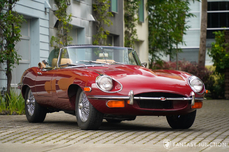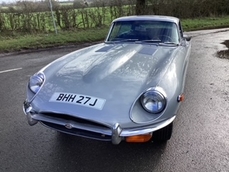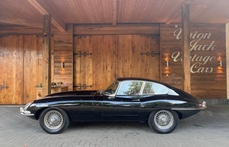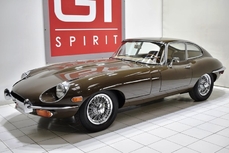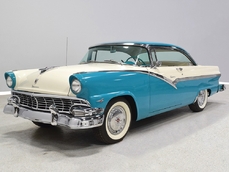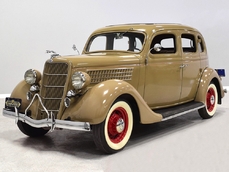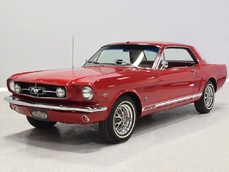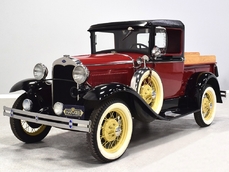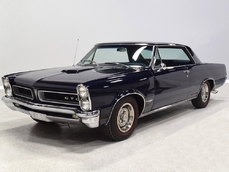Jaguar E-type 4.2 liter DOHC inline-6 1969
Allgemeine Beschreibung :
When discussing the Jaguar XKE, or the E-Type as it was called in its homeland, there are some things that we all assume are a given: it’s gorgeous, it’s expensive, and it’s one of the most delightful cars in the world to drive. Until you’ve driven one, you probably can’t quite grasp the downright joyous way they go about their business, with a remarkably supple ride, the bellowing six-cylinder engine note, and looks that make you want to study it from every angle. Never has a car been so right in so many ways, and the recent rise in E-Type prices finally justifies the passion that owners have held for these cars for so many years. There are few other cars that satisfy the mind, heart, and soul better than an E-Type.
While there’s a definite pecking order in terms of values among E-Type aficionados, if you’re someone who loves the drive a Series II car is what you want to own. More sophisticated, more powerful, and more spacious than the Series I cars, they were the result of all the feedback and upgrades done along the way. The 4.2 liter engine is wonderfully potent, yet tractable and user-friendly. Overheating issues were a thing of the past. The cabin was finally spacious enough for real-sized people. And it lost none of the sinuous grace of the original styling. Many call it a supercar for the masses, but I don’t think that’s quite right because supercars are finicky. I would call the E-Type a daily driver with the charisma and performance of a supercar.
Finished in brilliant Signal Red, this 1969 E-Type Series II has a recent and comprehensive restoration that shows its quality in multiple JCNA show wins. Although BRG is a favorite on Jaguars, if you’re going to attract attention, you may as well do it right with a bright red car—it’s just spectacular in person. It’s vivid and deep, and the shade is just right for a vintage Jag. The restoration was done to the highest standards and it likely fits together better now than when it was new, with even gaps and doors that latch easily without a heavy slam. It appears to be wearing all its original sheetmetal with no patches or replacements, but given the state of the art in Jaguar restorations, metalsmiths making replacement pieces disappear is not surprising. Either way, it is just beautifully done with no asterisks needed. The mirror-finish paint is show-quality with only one or two small signs that it has been driven, and obviously all the weather seals are new. Likewise, all the chrome was refinished to show standards, with only the rear bumper starting to show a few signs of age that likely comes from its proximity to the exhaust. Unavoidable. Lights, signals, lenses, and glass are all unmarked and like new. This is an exceptionally well-restored Jaguar.
The tan Connolly leather interior demonstrates why the Series II cars are so desirable for drivers. The seats are more adjustable than the early shells and far more plush for long trips. There’s more leg room and more room in the foot boxes so you don’t need to be a ballerina to heel-and-toe it. The leather seat covers show some minor comfort marks, and given the quality of the restoration and its relative youth, there’s a possibility that the seats might be original and just very nicely preserved, it’s hard to say. They’re not quite as nice as the rest of the interior, but they remain excellent and replacing them would probably be a mistake. On the other hand, the carpets, door cards, and dashboard are brand new, as is the bulkhead cover behind the seats. A lovely wood-rimmed Moto-Lita steering wheel is original, not a reproduction, and all the Smiths instruments are restored and operational. Big, easy-to-use rockers replaced the delicate toggles of the early cars and this one sports a Jaguar-logo AM/FM/cassette stereo head unit that certainly seems appropriate, although it’s quite modern with digital tuning. A new StayFast tan canvas top folds easily and offers fresh weather seals so it closes up reasonably well, although you should not expect a vintage Jaguar roadster to be water-tight—that just wouldn’t be proper. The trunk is likewise outfitted with a proper set of mats and side panels, as well as a matching chrome wire wheel in the tire well (which, you’ll note, is original and rust-free).
This is the car’s original, numbers-matching 4.2 liter DOHC inline-6. A little more displacement made it a much friendlier car on American roads, and the big six is happy to rumble along in 4th gear at barely more than a walking pace. It was fully rebuilt to stock specs during the restoration and it is properly tuned, unlike so many of its siblings. I remain convinced that Jaguar’s reputation for fussiness and unreliability is unwarranted, with the blame laying squarely on the shoulders of owners unwilling to maintain them to spec. This one, for instance, starts instantly and idles smoothly with a bit of choke. As it warms, push the choke in and it drops to a friendly 800 RPM idle, ready to enjoy. No drama, just turn the key and go. Even when it’s hot, it shows no bad habits, which is surely how it was when it was new and why I would argue that this is a supercar you can drive every day. The engine makes delightful noises and is beautiful to look at, as well. Finned cam covers, polished aluminum, and expert detailing make the underhood area almost too pretty to hide. Twin side-draft carburetors are easier to keep in synch than the earlier triple carb setup, yet give up nothing in the horsepower department. You also get a correct coil and Champion ignition wire set, a proper washer bottle on the firewall, and factory-style fittings and hardware used throughout. Someone clearly knew their Jaguars when this car came together.
The 4-speed manual gearbox is likewise numbers-matching, as is the independent rear end with 3.54 gears inside. The chassis is exquisitely detailed with painted subframes, a polished stainless steel exhaust system with resonators, and a protective textured layer on the floors and other vitals. Obviously everything is new or rebuilt and detailing is exacting, from the type of cotter pins used in the suspension to the splash shields around the soil pan. Jaguar’s wonderfully capable yet strangely supple and comfortable suspension tuning is something no other auto maker has been able to duplicate, and it’s quite evident in the E-Type, which seems to ignore bumps without becoming loose and soft-feeling. How’d they do that? Braking is effective and the sound from the twin pipes out back is worth dropping down a gear or two every time you go through a tunnel—after all, isn’t that part of why you own a Jaguar? Gorgeous chrome wire wheels with correct knock-off hubs glitter against the red paint and wear modern 205/70/15 Goodyear radials.
A Heritage Certificate has been ordered.
We’ve sold a few E-Types in recent months, and this is by far the finest in terms of quality and pedigree. Beautiful in every way that matters, fully functional, and ready to enjoy. You could show it and have some success, but after you slide behind the wheel and let the big cat seduce you, you’ll probably find that driving is what it loves most. Call today!
http://www.harwoodmotors.com/vehicles/inventory_details.php?id=861
1969 Jaguar E-type 4.2 liter DOHC inline-6 is listed verkauft on ClassicDigest in Macedonia by for $109900.
Fakten der Auto
Karosserietyp : Auto Marke : Jaguar Modell : E-type Ausführung : 4.2 liter DOHC inline-6 Hubraum : 4.2 Modelljahr : 1969 Karosstyp : Convertible Lage : Ohio
Verkauft
Angaben Zum Verkäufer
Verkauft
People who viewed this Jaguar E-type also viewed similar Jaguar listed at ClassicDigest
Other cars listed for sale by this dealer
über Jaguar
Ah, die Geschichte von Jaguar, von seinen Anfängen als SS Cars Ltd. bis hin zum Höhepunkt mit dem D-Typ und der Straßenversion des ikonischen E-Typs. An dieser Erzählung haftet etwas zutiefst Britisches, und ich werde sie erzählen, wie es ein britischer Journalist tun würde.Die Anfänge:
Unsere Reise in die Welt von Jaguar beginnt in den 1930er Jahren, als ein Unternehmen namens SS Cars Ltd. auftauchte. Trotz des unglücklichen Zufalls ihrer Initialen, die mit den aufkommenden politischen Spannungen in Europa zusammenfielen, begannen sie, stilvolle und leistungsorientierte Autos herzustellen. Der SS 100, der 1936 eingeführt wurde, war ein Symbol für Eleganz und Geschwindigkeit und legte den Grundstein für das, was Jaguar werden sollte.
Die Geburt von Jaguar:
Als der Schatten des Zweiten Weltkriegs näher rückte, entschied sich SS Cars Ltd. klugerweise, sich von den SS-Initialen zu distanzieren. So wurden sie 1945 offiziell zu Jaguar Cars Ltd., ein Name, der bald für britischen Luxus und Leistung stehen würde.
Die XK-Serie:
Die Nachkriegszeit von Jaguar brachte uns den XK 120, eine wahre Sensation im Jahr 1948. Mit seinem schlanken Design und einem leistungsstarken 3,4-Liter-Sechszylindermotor wurde er zum schnellsten Serienauto der Welt. Der XK 120 war die Blaupause für das, was kommen würde - Jaguars, die Stil mit Geschwindigkeit auf einzigartig britische Weise verbanden.
Die Dominanz des D-Typs:
Dann kam der D-Typ, eine wahre Rennlegende. 1954 eingeführt, gewann er in den 1950er Jahren dreimal Le Mans und zeigte die technische Kompetenz von Jaguar. Mit seiner innovativen Monocoque-Konstruktion und der ikonischen Finne hinten war der D-Typ der Höhepunkt von Jaguars Motorsporterfolgen.
Das Auftauchen des E-Typs:
Aber der wahre Wendepunkt kam 1961 mit der Einführung des E-Typs, oft von Enzo Ferrari als "das schönste Auto, das je gebaut wurde" bezeichnet. Seine lange Motorhaube, die geschwungene Karosserie und ein 3,8-Liter-Motor, der atemberaubende Leistung lieferte, machten ihn sofort zu einem Klassiker. Der E-Typ war nicht nur ein Auto; er war ein Kunstwerk auf Rädern und konnte auf der Straße 150 Meilen pro Stunde erreichen.
Straßen- und Rennsporterfolge:
Die Schönheit des E-Typs wurde durch seine Leistung auf der Rennstrecke unterstrichen. Die leichten E-Typen waren bei verschiedenen Rennveranstaltungen besonders erfolgreich und festigten den Ruf von Jaguar als eine Kraft, mit der man im Motorsport rechnen musste.
Das Zeitalter der Raffinesse:
Je tiefer wir in die Geschichte von Jaguar eintauchen, desto mehr erkennen wir, dass die 1950er und 1960er Jahre ein Zeitalter der Raffinesse und Expansion waren. Neben dem großartigen D-Typ und dem ikonischen Aufstieg des E-Typs führte Jaguar Modelle ein, die seinen Ruf für Luxus und Leistung weiter festigten.
Der MK2:
Ende der 1950er Jahre stellte Jaguar den MK2 vor, eine Sportlimousine, die Eleganz mit Leistung vereinte. Diese elegante viertürige Limousine war sowohl bei Bankräubern als auch bei der Polizei aufgrund ihrer außergewöhnlichen Geschwindigkeit und Handhabung beliebt. Der MK2 war ein Symbol für Jaguars Fähigkeit, Raffinesse mit Leistung zu verbinden und hatte auch eine erfolgreiche Rennkarriere.
Der XJ6:
Springen wir ins Jahr 1968, als Jaguar ein Auto auf den Markt brachte, das Jahrzehnte lang Luxuslimousinen definieren würde - den XJ6. Es war ein Meisterwerk der Ingenieurkunst und des Designs, mit einem sanften Reihensechszylindermotor, unabhängiger Hinterachse und einem geräumigen, wunderschön ausgestatteten Innenraum. Der XJ6 war ein Symbol britischer Eleganz und bot eine so sanfte Fahrt, dass es schien, als würde er förmlich über die Straße gleiten. Er wurde zum Flaggschiffmodell für Jaguar und setzte den Maßstab für Luxuslimousinen und zeigte ein Maß an Raffinesse, das die Konkurrenz staunen ließ.
Die Verschmelzung von Klassik und Moderne:
Während der MK2 und der XJ6 die Evolution der Limousinen von Jaguar repräsentierten, bewahrten sie das Engagement der Marke für Leistung und Luxus. Diese Autos gehörten nicht nur auf die Rennstrecke; sie fühlten sich genauso wohl auf den Prachtstraßen wie auf einer entspannten Fahrt durch die englische Landschaft.
Die Herausforderungen des Wandels:
Dennoch sah sich Jaguar mit dem Eintritt der 1970er Jahre, wie viele britische Automobilhersteller, finanziellen Herausforderungen und Veränderungen in der Eigentümerschaft gegenüber. Die Ära von British Leyland brachte sowohl Chancen als auch Schwierigkeiten mit sich, während die Marke durch verschiedene Fusionen und Übergänge navigierte.
Das Erbe des MK2 und des XJ6, zusammen mit dem D-Typ und dem E-Typ, definiert Jaguar weiterhin als einen Hersteller, der zeitlose Eleganz mit einer Leistungsstärke vereint. Diese klassischen Modelle, ob sie über kurvige Straßen gefahren oder als Sammlerschätze geparkt werden, dienen als Zeugnis für die anhaltende Präsenz von Jaguar in der Welt der automobilen Exzellenz.
Die Jaguar-Geschichte, von ihren Anfängen als SS Cars Ltd. bis zur Schaffung von Automobilikonen wie dem E-Typ, dem MK2 und dem XJ6, ist eine Reise, die das Wesen des britischen Automobilbaus widerspiegelt - eine Mischung aus Luxus, Leistung und Stil, die nach wie vor Enthusiasten und Kenner gleichermaßen fasziniert.



